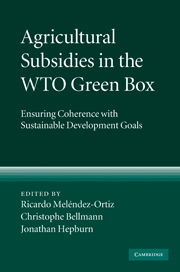Book contents
- Frontmatter
- Contents
- List of contributors
- Preface
- Acknowledgements
- List of abbreviations
- 1 Overview
- PART I The recent evolution of agricultural trade policy reform
- PART II The focus, extent and economic impact of green box subsidies
- PART III Green box subsidies and developing countries
- PART IV Green box subsidies and the environment
- PART V Looking forward: how can change take place?
- 19 Improving monitoring and surveillance of green box subsidies
- 20 EU subsidy reform: options for achieving change
- 21 Subsidy reform in the US context: deviating from decoupling
- 22 Agricultural trade policy reform in Japan: options for achieving change
- 23 Towards a green box subsidy regime that promotes sustainable development: strategies for achieving change
- Appendix: Text of Annex 2 of the WTO Agreement on Agriculture (“the green box”)
- Index
- References
19 - Improving monitoring and surveillance of green box subsidies
from PART V - Looking forward: how can change take place?
Published online by Cambridge University Press: 03 May 2010
- Frontmatter
- Contents
- List of contributors
- Preface
- Acknowledgements
- List of abbreviations
- 1 Overview
- PART I The recent evolution of agricultural trade policy reform
- PART II The focus, extent and economic impact of green box subsidies
- PART III Green box subsidies and developing countries
- PART IV Green box subsidies and the environment
- PART V Looking forward: how can change take place?
- 19 Improving monitoring and surveillance of green box subsidies
- 20 EU subsidy reform: options for achieving change
- 21 Subsidy reform in the US context: deviating from decoupling
- 22 Agricultural trade policy reform in Japan: options for achieving change
- 23 Towards a green box subsidy regime that promotes sustainable development: strategies for achieving change
- Appendix: Text of Annex 2 of the WTO Agreement on Agriculture (“the green box”)
- Index
- References
Summary
Background
Agricultural trade reform is based on the principle that further agricultural trade liberalization, together with progressive reductions in domestic support, will benefit both developing and developed countries. Pressures in favour of reform come not only from multilateral commitments, but relate also to the domestic setting, where agricultural policies need to take into account economic, political and social considerations.
Domestic pressures in favour of reform differ widely between countries. Developing countries' main concerns focus on the need to design policies aimed at facilitating structural adjustment, providing public goods and correcting market failures. Domestic pressures in developed countries are related to: (i) inconsistencies in traditional agricultural policies, with a huge proportion of subsidies historically being devoted to the same few products without taking into account major changes in their agricultural sectors; (ii) the need to address better issues related to environmental and conservation concerns; and (iii) the need to improve targeting of transfers, in order to keep supporting producers, but in a less production- and trade-distorting way.
As a result of such a wide range of requirements, there are legitimate reasons for ensuring that developing and developed countries are able to provide agricultural support in a way that facilitates reform processes.
The Uruguay Round and the Agreement on Agriculture (AoA) recognized this through the green box, allowing countries to support their producers as long as budgetary expenditures generate no or minimal distortions in production and trade.
- Type
- Chapter
- Information
- Agricultural Subsidies in the WTO Green BoxEnsuring Coherence with Sustainable Development Goals, pp. 571 - 582Publisher: Cambridge University PressPrint publication year: 2009

